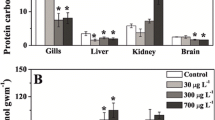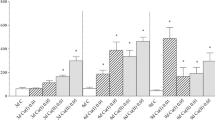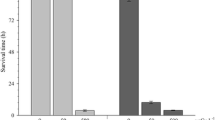Abstract
We assessed the acute and chronic effects of copper (Cu2+) on the antioxidant system in golden trout (Oncorhynchus mykiss aguabonita). The median lethal concentration after 96 h was determined as 0.24 mg L−1. We then used 0.06 (L) and 0.12 mg L−1 (H) Cu2+ to assess the responses of the antioxidant system to long-term exposure. The activities of superoxide dismutase, catalase, glutathione-S-transferase, glutathione peroxidase, glutathione reductase, reduced glutathione, and oxidized glutathione were measured in gill and liver tissue after 24 and 72 h and 7, 14, 21, and 28 days of exposure, as well as after 16 days of recovery in Cu2+-free water. Cu2+ accumulated to a greater extent in the liver than in the gill (0.61–0.75 mg kg−1 vs. 24.0–69.9 mg kg−1 in L group and 0.98–1.47 mg kg−1 vs. 33.3–66.03 mg kg−1 in H group). In the gill, we observed increases in the activities of superoxide dismutase, catalase, and glutathione peroxidase, as well as in the concentrations of reduced glutathione and oxidized glutathione. In the liver of L group, we observed increases in glutathione reductase activity and in the levels of reduced glutathione and oxidized glutathione. In L group, the activity of superoxide dismutase and reduced glutathione content increased after 24 h and then decreased over time, while catalase and glutathione reductase activity and oxidized glutathione levels increased. Data from the recovery period indicated that higher concentrations of Cu2+ may induce irreversible oxidative damage to the gill of golden trout.







Similar content being viewed by others
References
Boeck GD, Meeus W, Coen WD, Blust R (2004) Tissue-specific Cu bioaccumulation patterns and differences in sensitivity to waterborne Cu in three freshwater fish: rainbow trout (Oncorhynchus mykiss), common carp (Cyprinus carpio), and gibel carp (Carassius auratus gibelio). Aquat Toxicol 70:179–188
Campbell HA, Handy RD, Sims DW (2002) Increased metabolic cost of swimming and consequent alterations to circadian activity in rainbow trout (Oncorhynchus mykiss) exposed to dietary copper. Can J Fish Aquat Sci 59:768–777
Cerqueira CCC, Fernandes MN (2002) Gill tissue recovery after copper exposure and blood parameter responses in the tropical fish Prochilodus scrofa. Ecotox Environ Safe 52(2):83–91
Chapman GA (1978) Toxicities of cadmium, copper and zinc to four juvenile stages of Chinook salmon and steelhead. T Am Fish Soc 107:841–847
Chowdhury MJ, Girgis M, Wood CM (2016) Revisiting the mechanisms of copper toxicity to rainbow trout: time course, influence of calcium, unidirectional Na+ fluxes, and branchial Na+- K+ ATPase and V-type H+ ATPase activities. Aquat Toxicol 177:51–62
Cnubben NHP, Rietjens IMCM, Wortelboer H, Zanden JV, Bladeren PJV (2001) The interplay of glutathione-related processes in antioxidant defense. Environ Toxicol Phar 10:141–152
Crémazy A, Wood CM, Ng TY-T, Smith DS, Chowdhury MJ (2017) Experimentally derived acute and chronic copper biotic ligand models for rainbow trout. Aquat Toxicol 192:S0166445X17302060
Cusimano RF, Brakke DF, Chapman GA (1986) Effects of pH on the toxicities of cadmium, copper, and zinc to steelhead trout (Salmo gairdneri). Can J Fish Aquat Sci 43:1497–1503
David M, Munaswamy V, Halappa R, Marigoudar SR (2008) Impact of sodium cyanide on catalase activity in the freshwater exotic carp Cyprinus carpio (Linnaeus). Pestic Biochem Phys 92:15–18
De Boeck G, De Smet H, Blust R (1995) The effect of sublethal levels of copper on oxygen consumption and ammonia excretion in the common carp Cyprinus carpio. Aquat Toxicol 32:127–141
Donald D, Wood C, Chapman FJ, London H (1993) Branchial mechanisms of acclimation to metals in freshwater fish. In: Rankin J.C., Jensen F.B. (eds) Fish Ecophysiology. Chapman & Hall Fish and Fisheries Series, vol 9. Springer, Dordrecht
Driessnack MK, Jamwal A, Niyogi S (2017) Effects of chronic exposure to waterborne copper and nickel in binary mixture on tissue-specific metal accumulation and reproduction in fathead minnow (Pimephales promelas). Chemosphere 185:964–974
Driessnack MK, Matthews AL, Raine JC, Niyogi S (2016) Interactive effects of chronic waterborne copper and cadmium exposure on tissue-specific metal accumulation and reproduction in fathead minnow (Pimephales promelas). Comp Biochem Phys C 179:165–173
Eyckmans M, Benoot D, Raemdonck GAAV, Zegels G, Boeck GD (2012) Comparative proteomics of copper exposure and toxicity in rainbow trout, common carp and gibel carp. Comp Biochem Phys D 7:220–232
Figueiredo-Fernandes A, Fontaínhas-Fernandes A, Monteiro R, Reis-Henriques MA, Rocha E (2006) Effects of the fungicide mancozeb on liver structure of Nile tilapia, Oreochromis niloticus: assessment and quantification of induced cytological changes using qualitative histopathology and the stereological point-sampled intercept method. B Environ Contam Tox 76:249–255
Gaetke LM, Chow CK (2003) Copper toxicity, oxidative stress, and antioxidant nutrients. Toxicology 189:147–163
Gobi N, Vaseeharan B, Rekha R, Vijayakumar S, Faggio C (2018) Bioaccumulation, cytotoxicity and oxidative stress of the acute exposure selenium in Oreochromis mossambicus. Ecotox Environ Safe 162:147–159
Gopi N, Vijayakumar S, Thaya R, Govindarajan M, Alharbi NS, Kadaikunnan S, Khaled JM, Al-Anbr MN, Vaseeharan B (2019) Chronic exposure of Oreochromis niloticus to sub-lethal copper concentrations: effects on growth, antioxidant, non-enzymatic antioxidant, oxidative stress and non-specific immune responses. J Trace Elem Med Bio 55:170–179
Grosell M, Wood CM (2002) Copper uptake across rainbow trout gills: mechanism of apical entry. J Exp Biol 205:1179
Grosell MH, Hogstrand C, Wood CM (1997) Cu uptake and turnover in both cu-acclimated and non-acclimated rainbow trout (Oncorhynchus mykiss). Aquat Toxicol 38:257–276
Hidalgo MC, Expósito A, Palma JM, Mdl H (2002) Oxidative stress generated by dietary Zn-deficiency: studies in rainbow trout (Oncorhynchus mykiss). Int J Biochem Cell B 34:183–193
Iswarya A, M Anjugam, S Shanthini, B Vaseeharan (2019) Protective activity of beta-1, 3-glucan binding protein against AAPH induced oxidative stress in Saccharomyces cerevisiae. Int J Biol Macromol138:890–902
Javed M (2015) Chronic dual exposure (waterborne+dietary) effects of cadmium, zinc and copper on growth and their bioaccumulation in Cirrhina mrigala. Pak Vet J 35:143–146
Jiang WD, Liu Y, Jiang J, Wu P, Feng L, Zhou XQ (2015) Copper exposure induces toxicity to the antioxidant system via the destruction of Nrf2/ARE signaling and caspase-3-regulated DNA damage in fish muscle: amelioration by myo-inositol. Aquat Toxicol 159:245–255
Jiang WD, Wu P, Kuang SY, Liu Y, Jiang J, Hu K, Li SH, Tang L, Feng L, Zhou XQ (2011) Myo-inositol prevents copper-induced oxidative damage and changes in antioxidant capacity in various organs and the enterocytes of juvenile Jian carp (Cyprinus carpio var. Jian). Aquat Toxicol 105:543–551
John AR, Roman SD (2008) Antioxidant systems and oxidative stress in the testes. Oxidative Med Cell Longev 1:15–24
Kazlauskienė N, Vosylienė MZ (1999) Peculiarities of the physiological responses of rainbow trout (Oncorhynchus mykiss) to copper. Acta Zoologica Lituanica 9(2):15
Laurén DJ, Mcdonald DG (1987) Acclimation to copper by rainbow trout, Salmo gairdneri : biochemistry. Can J Fish Aquat Sci 44:99–104
Letelier ME, Martínez M, González-Lira V, Faúndez M, Aracena-Parks P (2006) Inhibition of cytosolic glutathione S-transferase activity from rat liver by copper. Chem Biol Interact 164:39–48
Maria VL, Bebianno MJ (2011) Antioxidant and lipid peroxidation responses in Mytilus galloprovincialis exposed to mixtures of benzo(a)pyrene and copper. Comp Biochem Phys C 154:56–63
Matés JM, Sánchezjiménez F (1999) Antioxidant enzymes and their implications in pathophysiologic processes. Front Biosci 4(4):D339–D345
Meng SL, Chen JZ, Xu P, Qu JH, Fan LM, Song C, Qiu LP (2014) Hepatic antioxidant enzymes SOD and CAT of Nile tilapia (Oreochromis niloticus) in response to pesticide methomyl and recovery pattern. Bull Environ Contam Toxicol 92:388–392
Meng SL, Qu JH, Fan LM, Qiu LP, Chen JZ, Xu P (2015) Responses of glutathione-related antioxidant defense system in serum of Nile tilapia (Oreochromis niloticus) exposed to sublethal concentration of methomyl and recovery pattern. Environ Toxicol 30:483–489
Meyer JS, Santore RC, Bobbitt JP, DeBrey LD, Boese CJ, Paquin PR, Allen HE, Bergman HL, Ditoro DM (1999) Binding of nickel and copper to fish gills predicts toxicity when water hardness varies, but free-ion activity does not. Environ Sci Technol 33:913–916
Niyogi S, Kamunde CN, Wood CM (2006) Food selection, growth and physiology in relation to dietary sodium chloride content in rainbow trout (Oncorhynchus mykiss) under chronic waterborne Cu exposure. Aquat Toxicol 77:210–221
Niyogi S, Nadella SR, Wood CM (2015) Interactive effects of waterborne metals in binary mixtures on short-term gill–metal binding and ion uptake in rainbow trout (Oncorhynchus mykiss). Aquat Toxicol 165:109–119
Oliveira M, Pacheco M, Santos MA (2008) Organ specific antioxidant responses in golden grey mullet (Liza aurata) following a short-term exposure to phenanthrene. Sci Total Environ 396:70–78
Ozcelik D, Uzun H (2009) Copper intoxication; antioxidant defenses and oxidative damage in rat brain. Biol Trace Elem Res 127:45–52
Sanchez W, Palluel O, Meunier L, Coquery M, Porcher JM, Aït Aïssa S (2005) Copper-induced oxidative stress in three-spined stickleback: relationship with hepatic metal levels. Environ Toxicol Phar 19:177–183
Schmidt MM., Dringen R (2012) Glutathione (GSH) synthesis and metabolism. In: Choi IY, Gruetter R (eds) neural metabolism in vivo. Advances in Neurobiology, vol 4. Springer, Boston, MA
Sfakianakis DG, Renieri E, Kentouri M, Tsatsakis AM (2015) Effect of heavy metals on fish larvae deformities: a review. Environ Res 137:246–255
Shuhaimi-Othman MNY, Ahmad AK (2010) Toxicity of copper and cadmium to freshwater fishes. World Acad Scie Engin Tech 65:869–871
Smith IK, Vierheller TL, Thorne CA (1989) Properties and functions of glutathione reductase in plants. Physiol Plantarum 77:449–456
Smith KS, Balistrieri LS, Todd AS (2015) Using biotic ligand models to predict metal toxicity in mineralized systems. Appl Geochem 57:55–72
Sokol RJ, Deverbaux MD, O'Brien K, Khandwala RA, Loehr JP (1993) Abnormal hepatic mitochondrial respiration and cytochrome C oxidase activity in rats with long-term copper overload. Gastroenterology 105:178–187
Srivastava S, Mishra S, Tripathi RD, Dwivedi S, Gupta DK (2006) Copper-induced oxidative stress and responses of antioxidants and phytochelatins in Hydrilla verticillata (L.f.) Royle. Aquat Toxicol 80:405–415
Upadhyay R, Panda SK (2010) Zinc reduces copper toxicity induced oxidative stress by promoting antioxidant defense in freshly grown aquatic duckweed Spirodela polyrhiza L. J Hazard Mater 175:1081–1084
Vieira LR, Gravato C, Soares AMVM, Morgado F, Guilhermino L (2009) Acute effects of copper and mercury on the estuarine fish Pomatoschistus microps: linking biomarkers to behaviour. Chemosphere 76:1416–1427
Wu G, Fang YZ, Yang S, Lupton JR, Turner ND (2004) Glutathione metabolism and its implications for health. J Nutr 134:489–492
Zhang J, Shen H, Wang X, Wu J, Xue Y (2004) Effects of chronic exposure of 2,4-dichlorophenol on the antioxidant system in liver of freshwater fish Carassius auratus. Chemosphere 55:167–174
Zyadah MA, Abdel-Baky TE (2000) Toxicity and bioaccumulation of copper, zinc, and cadmium in some aquatic organisms. B Environ Contam Tox 64:740–747
Funding
This work was financially supported by Beijing Natural Science Foundation, China (Grant No. 6194036), Beijing technical industry system project (BAIC08-2019), Key Laboratory of urban agriculture (North) of the Ministry of Agriculture (99124120), and the support of Beijing financial “Study on key techniques of breeding technology of steelhead trout and ornamental fish.”
Author information
Authors and Affiliations
Corresponding author
Ethics declarations
Conflict of interest
The authors declare that they have no competing interests.
Ethics approval and consent to participate
This paper does not contain any studies with human participants by any of the authors. No specific permits were required for the described field studies. No specific permissions were required for access to the artificial pond in Yanqing site of the Beijing Fisheries Research Institute, Beijing, China. The field studies did not involve endangered or protected species.
Additional information
Publisher’s note
Springer Nature remains neutral with regard to jurisdictional claims in published maps and institutional affiliations.
Rights and permissions
About this article
Cite this article
Chen, Y., Bai, Y., Hu, X. et al. Effects of chronic exposure of waterborne copper on the antioxidant system and tissue accumulation in golden trout (Oncorhynchus mykiss aguabonita). Fish Physiol Biochem 46, 1537–1547 (2020). https://doi.org/10.1007/s10695-020-00810-y
Received:
Accepted:
Published:
Issue Date:
DOI: https://doi.org/10.1007/s10695-020-00810-y




